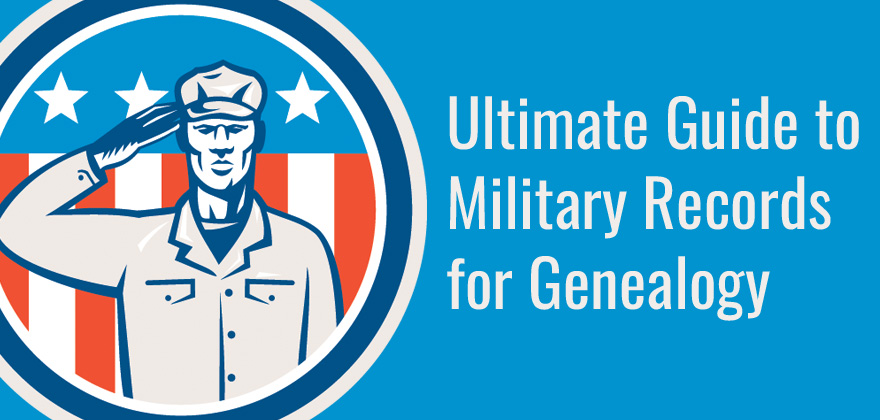Military records can give you a wealth of information you won’t find anywhere else. You can find information such as date and place of birth, details of next of kin, physical characteristics such as height, weight, hair color, and so much more.
This guide is a summary of the major U.S. wars from 1776-1945, along with the records generated before, during and after each war. We’ll talk about where you may find these records and what they might reveal.
How to Start Your Search for Military Records
To initiate a search for military records, certain key pieces of information are essential. The most critical details include the full name of the individual, their date of birth, and the specific branch of service in which they served (such as the Army, Navy, Air Force, or Marines). Additional helpful details can include service numbers, dates of service, and any known conflict or wartime service periods.
You should also think about whether your ancestor was likely to have served based on their age at the time of the war. To make things easier, I created a tool that will do the math for you.
Simply enter your ancestor’s birth year in the box below, and the tool will tell you which major U.S. wars your ancestor was of age to serve in between the Revolutionary War and World War II.
Was your ancestor of age to serve?
A few things to consider with this tool:
- Results are calculated using the average ages of men who would have served and/or been eligible for a draft. Remember that outliers will always exist such as “old men” regiments and children who served as buglers, drummers, etc.
- If your ancestor immigrated to the U.S. after 1775, consider the year they arrived. Make sure they were actually in the United States during the war where they were of age to serve.
- Data provided by FamilySearch.
Military Records by War
The rest of the guide will cover the specific records for each major war with U.S. involvement between the Revolutionary War and World War II.
Revolutionary War
Also known as the War of Independence, the Revolutionary War was fought to free the United States from British rule. In addition to the federal troops (Continental Army), state troops and local militias fought in this war.
Not all American participants fought for independence. You may have ancestors who were loyal to Britain and fought on the side of the Loyalists.
Over the duration of the war, 185,000 to 250,000 U.S. servicemen, aged 16-60, participated in this war.
According to the Department of Veterans Affairs, 4,435 U.S. servicemen died in battle and 6,188 were wounded.
- Service Records: Most War Department records were lost in fires between 1800-1814. In 1894, the government began compiling Revolutionary War service records from records of other government agencies.
- Revolutionary War Compiled Service Records contain information such as muster rolls, payrolls, returns, and other information. An index to the records can be accessed for free on familysearch.org. Records themselves can be found on Fold3 or Ancestry. Revolutionary War Naval records are also available at Fold3 and Ancestry.
- Access to Fold3 and Ancestry records may require a paid membership. However, you can often access these records for free at a public library or Family History Center.
- Revolutionary War Rolls: These collections can be found at Fold3 and Ancestry. They contain similar information to the Compiled Service Records but are copies of actual documents, rather than compiled records.
- The records on Fold3 are not searchable, but you can browse by state and name of the organization.
- The records on Ancestry have been indexed, but the search will only take you to the folder in which the record is contained. You will have to browse through the records to find the document of interest.
- Indexes: The General index to compiled military service records of Revolutionary War soldiers, a National Archives microfilm, can be accessed at many libraries. The index is an alphabetical list of soldiers, sailors, members of the Army staff departments, and civilian employees of the Army and Navy. The index lists name, rank, unit, and profession or office. A four-volume set of books transcribing the index is also available.
- Books: There are a number of books in publication that list or provide biographical sketches for revolutionary war veterans. A list of related books can be found on the Family Search Wiki for Revolutionary War Records. In addition to looking in libraries, searching the title of the book online may take you to an online version or a place to order the books.
- Pension Records: Revolutionary War veterans were granted pensions in 1776 if they had become disabled in the service and could not make a living.
- In 1818, all Revolutionary War veterans were granted pensions based on service, but the law was later amended to only give pensions to those who were disabled.
- In 1832, pensions were again granted to veterans based on service, and widows were also allowed to claim pensions.
- Pension applications prior to 1800 were destroyed by fire.
- The National Archives has Revolutionary War pension applications dating from 1800. Indexes to these pension applications are available at familysearch.org and records are available on Fold3 and Ancestry. Microfilm copies of the National Archive records may be accessible at libraries.
- Bounty Land Warrants: After the war, veterans (federal, state and local) were granted free land by the federal government and many states. You can search an index of land grants on Ancestry. In addition, online records pension application records listed above also include bounty land applications.
- Loyalist Records: Many Loyalists settled in Nova Scotia, New Brunswick or Ontario, Canada during or after the war. Some returned after the war, but many remained away. Some records of Loyalists can be found in Ancestry’s UK, American Loyalist Claims, as well as several books that can be accessed on Ancestry. Other good resources for information about Loyalist troops and their fate have been recorded on Olive Tree Genealogy.
War of 1812
The War of 1812 was fought between the United States and Britain and resulted from U.S. objections to Britain’s trade policies, imprisonment of U.S. sailors, and support of Indian attacks on the frontiers.
The Americans attacked Canada and the British attacked the Southern US. The war ended with a return to the pre-war status quo, with neither side gaining territory.
According to the Department of Veterans Affairs, 286,730 U.S. servicemen were involved in the war. This included both U.S. forces and militia troops.
The Family Search Wiki on the War of 1812 says the average age of servicemen was between 18 and 35, with some as young as 10 and some as old as 70.
According to the Department of Veterans Affairs, 2,260 Americans were killed in battle, and an additional 4,505 were wounded.
- Service Records: Service records are held by the National Archives and to date are not available online or on microfilm. Indexes to the service records can be searched on Ancestry and FamilySearch. The indexes provide the serviceman’s name, company, and rank. Copies of the compiled service records can be ordered from the National Archives. The National Archives does not hold state militia records. Military Indexes has a list of which states are available online, with links to the information.
- Pension Records: War of 1812 Pension applications can be accessed for free on Fold3. Each application is about 10-30 pages long and contains information about the soldier’s service and his family. About 75% of all pension applications are currently available. An index to the applications can be accessed on Ancestry.com (for a fee) or on FamilySearch (free).
- Prisoner of War Records: Ancestry.com has War of 1812 Prisoner of War records online. These are indexed by name. If you find an ancestor’s name in the index, you can find pertinent records in the referenced manuscripts.
- Bounty Land Warrants: The National Archives has bounty land warrant applications based on service between 1775-1855.
Mexican-American War
The Mexican-American War resulted from the United States’ annexation of Texas in 1845 and a dispute over the border between Mexico and Texas.
As a result of the war, the U.S. acquired more than 500,000 square miles of Mexican territory, extending from Texas to the Pacific coast.
According to the Department of Veterans Affairs, 78,718 U.S. servicemen were involved in the war. U.S. troop deaths during the war number 13,283 and 4,152 were wounded.
Between 1802 and 1838, federal law required military servicemen to be between 18 and 35 at the time of their enlistment. State militias may have had different rules.
- Service Records: Service record indexes for volunteers who participated in the Mexican-American War are available on Fold3, as are some service records for a number of states. FamilySearch has indexes for some states, as does Ancestry. Compiled military records for some states are on Ancestry.
- Pension Records: Mexican-American War Pension Index is available on FamilySearch. The documents can be ordered from the National Archives.
- Bounty Land Warrants: The National Archives has bounty land warrant applications based on service between 1775-1855.
U.S. Civil War
The U.S. Civil War was fought between the Union States and 11 southern states that seceded from the Union and formed the Confederate States of America. The Union won the war, preventing the Confederate States from establishing a separate country.
Servicemen involved in the war numbered 2,213,363 for the Union and approximately 1,050,000 Confederate troops.
Troop deaths during the war were 364,511 for the Union and approximately 163,000 Confederates.
The Union had 281,881 wounded. No data is available for Confederate wounded.
According to U.S. law, men between 18 and 44 could enlist in the Union military. Boys under 18 could volunteer with their parent’s permission in the early years. The Confederate military required men between 18 and 35 to serve. The Confederacy did not have age restrictions on volunteers.
Since ages were provided by the enlisting soldier, many boys younger than 18 served during the war. Boys as young as nine served as buglers, drummers, messengers and stretcher bearers.
State militias often had soldiers in their 50’s and 60’s who participated in the war.
There are a good number of records available for Civil War veterans. In general, the records for the Union Army are retained at the National Archives. Records for Confederate veterans are retained at state archives.
This includes draft registration, service records, casualty records, pension records, prisoner of war records, and cemetery records as well as records created at the state level for state militias.
Many records have been either transcribed or digitized and are available online. Other records may have indexes online and copies of the records may be ordered.
The Civil War Soldier and Sailor database lets you search for military men on both sides of the conflict. It also includes information on regiment histories, cemeteries, battles, prisoners, medal of honor recipients and Civil War monuments.
- Draft registration records: Between 1863 and 1865, all males between 20 and 45 in the Union were required to register for the draft. Draft records are available online at Ancestry. Note that draft records are not available for the Confederate Army.
- Service Records: Service records for Union combatants can be found in a number of places, including National Archives records and records for individual states. A summary of available online records can be found in Military Indexes and FamilySearch wikis. Compiled service records for Confederate military men are available online at Fold3 and FamilySearch. The Fold3 collection also includes records for individual states. The FamilySearch Wiki for Confederate records provides more information on where records can be found online.
- Casualty Records: The Final Statements, 1862-1899 are records of soldiers who served in the Regular Army who died in service. The collection can be viewed online at Fold3. The Historical Register and Dictionary of the U.S. Army, Volume 2, Part 3 contains a list of casualties of officers in the Civil War (both Union and Confederate). It is available online at Ancestry.com, Google Books and Internet Archive.
- Prisoner of War Records: Union Prisoner of War Records are available online and can be accessed by the location of the prison. A list of the sites with these records is listed in the FamilySearch Wiki. Confederate Prisoner of War Records are available online at Ancestry, FamilySearch, and Findmypast.com. A summary of the available records can be found online at the FamilySearch Wiki.
- Pension Records: Union soldiers, as well as nurses who served during the Civil War, were eligible for pensions. Soldiers incurring death or disability during the war received pensions beginning in 1862. Later pension laws allowed pensions for Civil War veterans based on length of service as well as disability not necessarily incurred during service. Widow’s pensions were also allowed for some veterans. There are pension indexes online at FamilySearch. Some, but not all, widows pension applications are available online at Fold3. Pension records for Civil War Veterans can be ordered from the National Archives.
Spanish-American War
The Spanish-American War resulted from the U.S. intervention in Cuba’s struggle for independence from Spain. The war lasted from April to August of 1898 and resulted in the Treaty of Paris where Spain gave up all claims to Cuba, ceded Guam and Puerto Rico to the United States, and transferred sovereignty over the Philippines to the United States for $20 million.
In this brief war, 306,760 U.S. servicemen were involved. According to the Department of Veterans Affairs, 2,446 U.S. troops died during the war and 1,662 were wounded. Combatants were from the navy, marines, and army.
- Service Records: The National Archives does not have compiled service records for Spanish American veterans. Personnel records for Spanish American War veterans are kept in the National Personnel Records Center in St. Louis, Missouri. These records can be ordered from the service center.
- Naval personnel information can also be found on muster rolls and conduct books.
- Marine personnel records are at the National Archives for marines discharged before 1906 and at the National Personnel Records Center in St. Louis for those discharged after 1906.
- The National Archives has a microfilmed document General Index to Compiled Service Records of Volunteers Who Served During the War With Spain, that lists volunteers in state militias. You can then obtain compiled service records from the archives.
- Many state records are available online at Ancestry or state archive websites.
- Fold3 has records relating to the Spanish-American War, some that are free. This includes a Spanish-American War Service Record Index and Florida’s Spanish-American War Service Records.
- There are also Army, Navy and Marine records on Fold3 that include the Spanish-American War period.
- Pension Records: Pension records for the Spanish-American war are intermixed with those for the Civil War in record indexes. The National Archives microfilm document, General Index to Pension Files, 1861-1934, can help you identify ancestors who served in this war and learn their branch of service, rank, and military organization, which can then be used to search for service records. Other Records held by the National Archives that relate to the Spanish-American War include records for medical personnel and court martials.
World War I
World War I originated in Europe and the United States remained neutral for the first two years of the war. After multiple incidences of German provocations, the U.S. entered the war in 1917. World War I ended November 11, 1918 with an armistice.
According to the Department of Veterans Affairs, 4,734,991 U.S. servicemen were involved in the war. U.S. troop deaths during the war numbered 116,516 while there were 204,002 wounded. Men between the ages of 17 and 45 were eligible to serve during WWI.
Draft cards
According to the National Archives, there were three draft registrations for World War I.
- Men between the ages of 21-31 were registered in June 1917
- Men who turned 18 after June 1917 were registered in June 1918
- Men between the ages of 18 and 45 were registered on September 12, 1918
The records reported the registrant’s name, address, date, and place of birth, citizenship status, current employment, next of kin, and physical description, as well as any exemptions claimed.
Digitized images of the cards can be found on Ancestry.com and FamilySearch, as well as a number of other genealogy websites. Note that not all men who registered for the draft served in the military so a draft card may be the only record you’ll find.
- Service records: Personnel Records for World War I veterans are held at the National Personnel Records Center in St. Louis, Missouri. They can be ordered by mail. The service records for most WWI Army personnel were lost in a fire in 1973. State-level records are often the only records that remain. Some state records for World War I veterans are online.
- Pension records: There were no pensions automatically granted to World War I veterans from the federal government. In 1924, veterans were awarded a bonus certificate that couldn’t be redeemed until 1945. For men who died or were injured in the service, FamilySearch has an online index of veterans or their heirs who made a pension or benefit claim with Veterans Administration between 1917-1940. Fold3 has U.S. VA pension payment cards between 1907 and 1933.
- Death records: Death records for World War I veterans are found in many places. Soldiers of the Great War is a book, available online, that lists World War I deaths. In addition, there are various death records available online at the National Archives, FamilySearch, and Ancestry.
World War II
World War II was fought between the Axis Powers (Germany, Italy, and Japan) and the Allies (which included Great Britain, France, Australia, Canada, New Zealand, China, India, the Soviet Union, and the United States).
It officially began in 1939 when Germany invaded Poland. U.S. involvement was by Japan’s attack on Pearl Harbor on December 7, 1941. The war officially ended on December 2, 1945 after the United States dropped two atomic bombs on Japan.
During World War II, 16,112,566 U.S. servicemen were involved. American troop deaths numbered 405,399 and 670,846 were wounded.
- Draft Records: In 1940, Congress required all men between the ages of 21 and 36 to register for the draft. Between 1941 and 1943, there were five more drafts and the ages for registering were expanded to 18-45. The exception was the fourth registration, termed “The Old Man’s Draft” that registered men over 45. Draft card images and transcriptions can be found online at Fold3, Ancestry, and FamilySearch.
- Service Records: Personnel Records for World War II veterans are held at the National Personnel Records Center in St. Louis, Missouri. They can be ordered by mail. The service records for most WWII Army and Air Force personnel were lost in a fire in 1973. In some cases, records have been reconstructed from documents from other agencies.
- Pension Records: World War II veterans received benefits through the Veterans Administration (now the Department of Veterans Affairs). These records are not currently available to the public.
- Death and Missing in Action Records: The Defense POW/MIA Accounting Agency maintains a database of service personnel not recovered in World War II. World War II casualty lists for the Army and Air Force are available on the National Archives as well as lists for the Navy, Marine Corps, and Coast Guard.
- State Level Records: Many are available online. They include selective service records, death records, grave registrations, oral histories, and newspaper clippings.
Verifying Military Service
Confirming a person’s military service is a crucial step in military genealogy. Various methods can be employed to verify such service, including submitting Freedom of Information Act (FOIA) requests to obtain military records or using online service verification portals offered by various government agencies. These resources provide an official way to access detailed records about an individual’s military history, rank, and possibly the details of their service and discharge.
Clues in Census Records
You can also look to census records for clues.
The 1910 and 1930 U.S. censuses indicate whether someone was a veteran of the Civil War – the 1910 census also lists which side they fought for and which branch of the military (Union Army, Union Navy, Confederate Army, Confederate Navy).
The 1930 census also indicates if someone served in other major wars such as World War I and the Spanish-American War.
Clues in Death Records
Death and cemetery records can also provide clues. Cemetery records may reflect service information regarding your military ancestors.
Find-A-Grave may have photos of the ancestor’s grave that details their military service. Military ancestors may be buried in a national or state veterans cemetery, where their service is detailed both on the grave marker and in the cemetery’s records.
The Department of Veterans Affairs has an online grave locator for veterans buried in national cemeteries, state veteran cemeteries and private cemeteries where a military grave marker has been issued.
There are also online state databases for military graves.
Military Lineage Societies
There are more than 200 lineage societies in the US, many of them for descendants of U.S. military veterans.
Members of lineage societies have demonstrated both their link to the veteran ancestor as well as documented their ancestor’s military service.
Many of these societies will make that information available either for free or at a price.
Two societies in particular which are fantastic resources are Daughters of the American Revolution (DAR) and Sons of the American Revolution (SAR). Many of their records can be accessed at Ancestry.com and Fold3.



